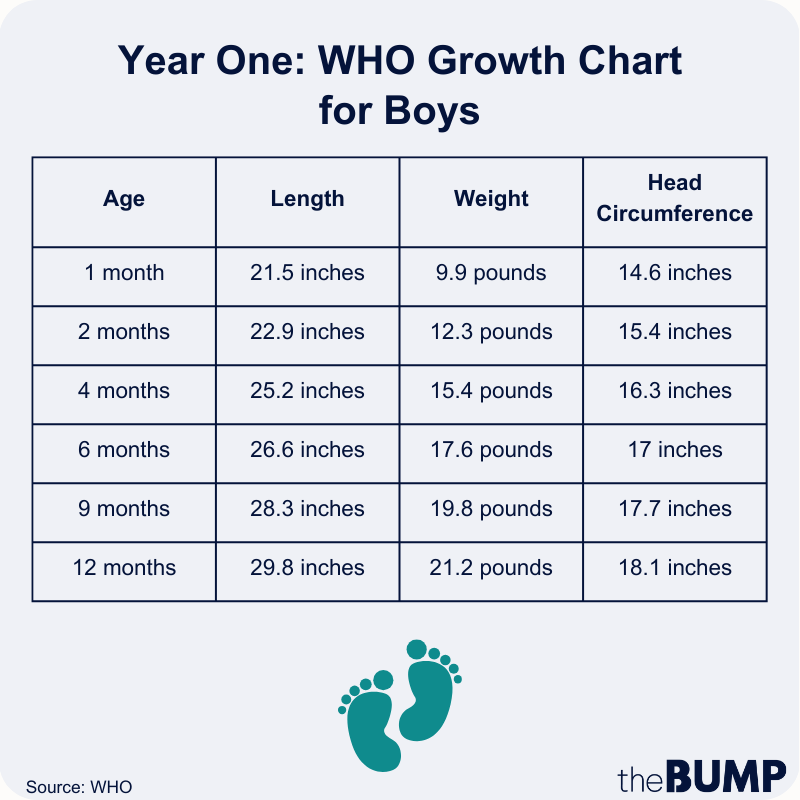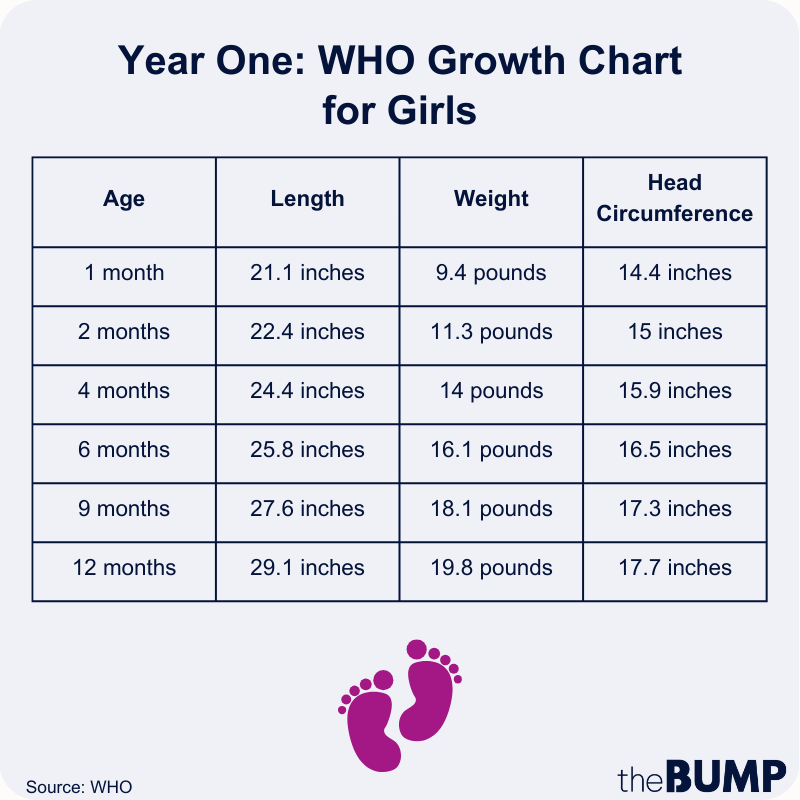Infant Growth Charts: Tracking Baby’s Development
As every cheek-pinching grandparent knows, a growing baby is a healthy baby. But how do you know if your child’s growth is on track? Enter the baby growth chart, the major tool your pediatrician uses to plot baby’s physical development at every wellness checkup. The infant growth chart may look intimidating, with its dots, curves and height and weight percentiles, but it’s easy to decipher with a little background and the help of your provider. Here, experts explain what you really need to know about using infant growth charts to track baby’s growth.
An infant growth chart is exactly what it sounds like: a chart that tracks baby’s growth. It specifically measures baby’s height (also called length), weight and head circumference according to their age in months, explains Denise Scott, MD, an Oklahoma-based pediatrician. Your provider will measure all three of these factors at each of baby’s wellness checkups, then add a dot to the graph to plot your child’s latest measurements. Baby’s growth curve is just those dots connected over time. This curve is measured against the existing baby growth curves you see on an infant growth chart, which reflect average growth for boys and girls based on their age. Baby growth charts show providers how baby’s growth is tracking over time and are “critical in following growth trends,” Scott says.
What do percentiles mean on baby growth charts?
Infant height and weight percentiles reflect how baby compares to other babies of the same age, Scott explains. According to Britannica, a percentile is a number that shows the position of a data point within a dataset. While this may sound confusing, all it really means is that, if there are 100 babies and your child lands in the 40th percentile for height, that means that 39 babies are smaller and 59 babies are bigger. “The height and weight percentiles are a comparison to infant’s of the same age, with a normal range shown on the chart as anywhere from the 5th to the 95th percentile,” Scott says. “For example, a baby plotting at the 95 percent in weight for age means that this baby weighs more than 95 percent of other babies the same age, and 5 percent weigh more.”
When it comes to average baby percentiles, lower numbers usually mean baby’s on the smaller or lighter side, and higher numbers mean they’re on the taller or heavier side. But keep in mind, it’s not a contest. “Bigger isn’t better and smaller isn’t better,” says Karen E. Breach, MD, assistant specialty medical director of Carolinas HealthCare System in North Carolina. “When parents ask why their child isn’t in the 95th percentile, I remind them that it’s not a score on a test.” Instead, baby’s growth will reflect your own family’s stature and how much baby is eating and growing.
How to read infant growth charts
Wondering how to read newborn growth charts? “Baby’s age is along the bottom horizontal or X-axis, and the weight, height or head size is plotted along the vertical or Y-axis to give a point along a growth curve,” Scott explains. “Where baby plots is reported as a percentile, compared to other babies of the same age.” For further information and explanation, she suggests asking baby’s provider to show you how to read their growth chart.
Doctors will measure at every checkup, which will start at birth, after 3 to 5 days and at months 1, 2, 4, 6, 9, 12, 15, 18, 24, 30, 36 and then annually after that. The main thing your doctor is looking for is consistency. “Do I care about the absolute number on the chart? No, I don’t,” said the late pediatrician Charles Shubin, MD, who served as the director of the Children’s Health Center at Mercy FamilyCare in Maryland and the associate professor of pediatrics at the University of Maryland and Johns Hopkins University. “What’s important is the pattern of growth—how they’re progressing.”
Wondering if you should track baby’s growth at home? The short answer: Don’t bother, as it’s entirely unnecessary. “Children get measured at every checkup, on the same scale, in the same way, so we get the most accurate weight,” says Breach. And if the doctors are the least bit concerned? “We’ll schedule extra weigh-ins,” she says. “Seriously, the best way to monitor your child’s growth is to come to the well checkups.”
What’s a normal growth rate?
Unfortunately, there isn’t a clear answer here because “normal” varies so much for each kid. “What’s normal is what’s normal for your child,” Breach says. “It doesn’t matter that your cousin’s baby is bigger or that the neighbor’s baby is smaller. What matters is if your baby is growing on their chart.”
At its core, normal growth means baby’s measurements—height, weight and head circumference—are increasing at every appointment. Whether boy or girl, breastfed or formula-fed, steady development is what’s important. “If your baby is 25th percentile in weight and suddenly shoots up to the 95th percentile, I’m going to worry that they’re being overfed,” Breach says. “If baby’s been measuring in the 25th percentile and then suddenly they’re down to the 3rd percentile, that could also be a problem.” If baby is born preterm, doctors will use a gestational age adjustment to plot their numbers.
It’s also important to know that, during the first two to three months, breastfed babies may gain weight more quickly than their formula-fed peers. That’s likely because breastfed babies may eat more often—they’re probably nursing on demand rather than by a schedule—and moms aren’t measuring how much milk they’re getting.
The American Academy of Pediatrics (AAP) recommends using the World Health Organization’s (WHO) infant growth chart for babies from birth to 24 months. The WHO chart, officially called The WHO Child Growth Standards, was developed in 2006 based on optimal growth rates for mostly breastfed babies in the US and Europe. “It was initially used for breastfed babies, but it’s really for all babies,” Breach says.
After baby reaches 24 months, pediatricians may continue to use the WHO infant growth charts or switch to the baby growth chart developed by the Centers for Disease Control and Prevention (CDC) for ages 2 to 20. One of the biggest differences between the two is that the WHO baby growth chart measures body-mass index (BMI) from birth, while the CDC chart starts at age 2. According to Breach, both charts are comparable after age 2.
Baby boy growth chart
The following baby boy growth chart, based on data from WHO, looks at babies’ first 12 months (but keep in mind the one from WHO goes until 24 months). It outlines growth measurements, including length, weight and head circumference.
Baby girl growth chart
The baby girl growth chart below, based on data from WHO, describes growth patterns for baby’s length, weight and head circumference within the first year of baby’s life. (Again, note the one from WHO goes until 24 months.)
Baby’s provider is in the best position to track their growth, but definitely speak up if you’re concerned. Here’s how pediatricians are likely to address baby’s position on the growth chart relative to the standard curve.
Weight
Being underweight isn’t the same as not growing. If baby is measuring on the low side for weight on their baby weight chart, but is still growing well, there’s probably no problem, especially if the family tends to be genetically on the thinner side. If baby’s weight is either significantly below average or baby isn’t growing well, doctors will look at whether baby is eating enough. “Typically, underweight infants who are otherwise healthy are usually just underfed,” Breach explains. If they’re eating enough but still not gaining weight, doctors will look for an underlying medical condition such as celiac disease, a thyroid problem or cystic fibrosis.
If baby is overweight, it’s typically a result of overfeeding. “My goal is never for them to lose weight but to gain weight at a slower pace as they grow,” Breach says. “We don’t put kids on a diet.” Most babies slim down anyway as they get more mobile and start to roll, sit up, pull up, crawl and walk. Very rarely, too-rapid weight gain can be associated with health problems, such as endocrine disorders. Again, talk to baby’s provider if you’re concerned.
Length
Just being tall isn’t a cause for concern, especially if baby’s parents are tall. “When a child is consistently above the growth curve, I always say, ‘What do you think Shaquille O’Neal looked like at that age?’” Breach says. But if baby is growing steadily and then makes a sudden jump, you may be referred to an endocrinologist.
Similarly, a petite baby is not a problem (especially if it runs in the family), unless they’re not growing a minimum of half to one inch per month, or if the baby growth curve is flat or dropping. In those cases doctors will likely test for treatable issues, such as growth hormone deficiencies or problems with absorbing nutrients (like celiac disease).
Frequently Asked Questions
What does it mean if baby’s growth pattern changes?
“If the growth pattern changes, that usually refers to either more rapid growth or slower growth than expected,” Scott says, adding, “At specific ages, a baby’s growth pattern will normally change.” Most notably, baby’s growth will slow, which is evidenced in the decreasing slope of the baby growth curve. For example, baby will gain weight quickly in their first four months and then start to slow down. “There is a gradual slowing to the age of three, then growth in height and weight gain is more consistent until the pubertal years,” Scott says.
What are some signs that indicate a problem in baby’s growth?
“The beauty of the growth chart is that it can help to point to a health issue by the pattern of growth displayed,” Scott says. She says some signs that may indicate a problem in baby’s growth include:
- Not gaining weight: This could be a sign of a gastrointestinal issue, cystic fibrosis or another chronic disease
- Head size growing too quick or slow: This combined with baby crossing percentiles upward or downward could indicate issues with baby’s skull and brain development
- Not gaining height: This could indicate a skeletal, nutritional or hormonal issue
“Fluctuations in growth and changes in percentiles also may not indicate any problem, but are simply a sign to the doctor to follow things more closely,” she adds.
Why are the WHO and CDC baby growth charts different?
In a nutshell, they’re different because they serve different populations. The WHO baby growth chart takes into account data from infants around the globe, Scott notes, whereas the CDC baby growth chart focuses on data primarily from infants in the US.
Ultimately, when it comes to tracking baby’s growth, baby’s pediatrician is on it. “I don’t think any question is a silly question, but my key take-home message is: Don’t try to manage this yourself,” Breach says. Genetically, “children are models of their family, so big people have big children and small people have small children.” Your job, she says, is to offer a healthy diet and development opportunities. Beyond that, relax and enjoy this time with baby.
Plus more from The Bump, What You Need To Know About Baby Growth Spurts:
Please note: The Bump and the materials and information it contains are not intended to, and do not constitute, medical or other health advice or diagnosis and should not be used as such. You should always consult with a qualified physician or health professional about your specific circumstances.
Karen E. Breach, MD, is an assistant specialty medical director of Carolinas HealthCare System in North Carolina. She earned her medical degree from George Washington University School of Medicine and has been in practice for over 20 years.
Denise Scott, MD, is a pediatrician with JustAnswer and a pediatric endocrinologist based in Oklahoma with over 30 years of experience. Certified in culinary medicine, Scott also runs the blog Feed Future Health and is the author of Feed Your Child's Future Health: Prevent Disease Before it Starts. She received her medical degree from the University of Texas Medical Branch and completed her residency at the University of Oklahoma Health Sciences Center with a fellowship at the National Institutes of Health.
Charles Shubin, MD, served as the director of the Children’s Health Center at Mercy FamilyCare in Maryland and the associate professor of pediatrics at the University of Maryland and Johns Hopkins University. He completed his medical degree at Temple University and his residency at St. Christopher's Hospital for Children in Philadelphia. He passed away in 2019 after a life and career committed to children and pediatrics.
Centers For Disease Control and Prevention, WHO Growth Chart: Birth to 24 months, November 2009
Britannica, Percentile
American Academy of Pediatrics, WHO Growth Chart
Centers For Disease Control and Prevention, WHO Growth Standards Are Recommended for Use in the U.S. for Infants and Children 0 to 2 Years of Age, September 2010
Centers For Disease Control and Prevention, Clinical Growth Charts, June 2017
Learn how we ensure the accuracy of our content through our editorial and medical review process.
Navigate forward to interact with the calendar and select a date. Press the question mark key to get the keyboard shortcuts for changing dates.






















































